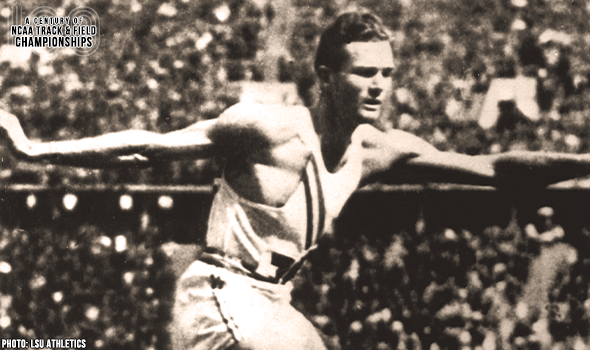
LSU’s Hardin Completed Unique 440-220H Double Twice
Glenn Hardin of LSU had a debut never seen before at the 1933 NCAA Outdoor Track & Field Championships at Chicago’s Soldier Field.
Hardin was just a sophomore when he entered an unlikely combination of events, the 440 yards and 220-yard hurdles. Hardin owned the year’s world-leading performances in both events, and his unique background meant running both – and well – on the same day was possible.
The LSU standout owned the world record and Olympic silver medal in the 400-meter hurdles, an event that was still a few years away from being offered on the NCAA’s championship menu. He earned the WR and medal the previous summer at the Los Angeles Olympics (the gold medalist’s time wasn’t eligible then for a record because of a knocked-over hurdle).
The closest call for Hardin in the NCAA meet came in the 440, but his meet-record 47.1 was a new world-leading mark and just held off Ivan Fuqua of Indiana and Ed Ablowich of Southern California. The previous summer Fuqua and Ablowich ran the opening two legs of the gold-medal winning U.S. 4×400 relay team at the Los Angeles Olympics.
Less than an hour later, Hardin was back on the track, skimming over the 220 hurdles – 6 inches lower than the 400 intermediates – in 22.9 to match his own world-leading time. Both of Hardin’s 22.9 times were faster than the ratified world record of 23.0 at the time, but neither received official recognition.
Hardin’s team-high 20 points were important for LSU, which would end up winning the team crown by four points in an upset over USC. You might also remember that Matt Gordy notched a walk-off victory in the pole vault to give the Tigers the decisive margin.
The 1934 season saw more of the same uniqueness from Hardin, except that the man known as “Slats” was even faster (He gained the nickname in high school because he was so tall and thin, like the slats for a bed).
Though Fuqua gained an early-season victory on Hardin’s home track in a dual meet, Hardin came through with another NCAA meet record as the meet moved away from Chicago for the first time. Running again at the Los Angeles Memorial Coliseum, Hardin won the 440 in 47.0, and no one was close in the 220 hurdles as he lowered the world best to 22.7 (again unratified).
Hardin proved most formidable in the 400-meter hurdles during the summer of 1934, lowering his world record to 50.6, a mark that would stand for 19 years.
His collegiate career ended in 1935 after another remarkable effort at the NCAA Outdoor Championships, but this time he found his match in each event. Hardin finished third in the 440 (UCLA’s Jimmy LuValle won) and runner-up in the 220 hurdles to Jesse Owens of Ohio State.
As a post-collegian in 1936, Hardin won Olympic gold in the 400 hurdles in Berlin. By 1964, the 400H was regularly on the NCAA schedule and his son Billy won the title for LSU, completing the meet’s first father-son combination of NCAA champions. Billy’s time, a meet-record 50.2, gave him the family best.
The NCAA and collegiate track & field will mark a momentous milestone in the spring of 2021 -- the 100th anniversary of the NCAA Championships and with that, the NCAA Track & Field Championships. In June 1921, the University of Chicago hosted the first track & field championships in NCAA history.
This point can’t be emphasized enough: Not only was the event the first for NCAA track & field, but the first championships for any sport under the sponsorship of the NCAA.
To celebrate, over each of the next 365 days, the U.S. Track & Field and Cross Country Coaches Association (USTFCCCA) will celebrate moments, student-athletes, and coaches that have made a century’s worth of championships special. From humble beginnings to important historical milestones to the modern-day, collegiate track & field has evolved with the American society.
The 2021 edition of the NCAA Division I Outdoor Track & Field Championships begin with preliminary round action on May 27-29 in Jacksonville, Fla., and College Station, Texas. The championships final site and culmination of the celebration is slated for June 9-12, 2021 at the newly rebuilt Hayward Field in Eugene, Ore.
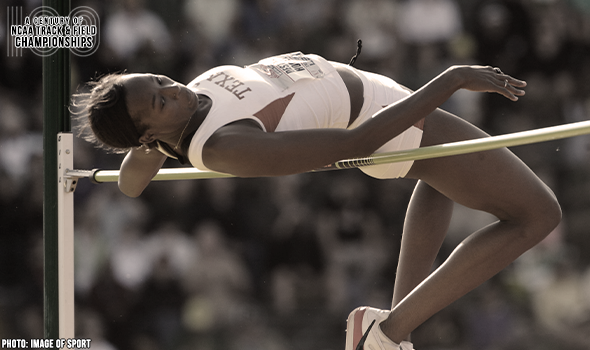
Texas’ Hooker High Jumped To NCAA Glory
Destinee Hooker won three career high jump titles at the NCAA DI Outdoor T&F Championships, including a massive victory in 2009 by more than two inches.
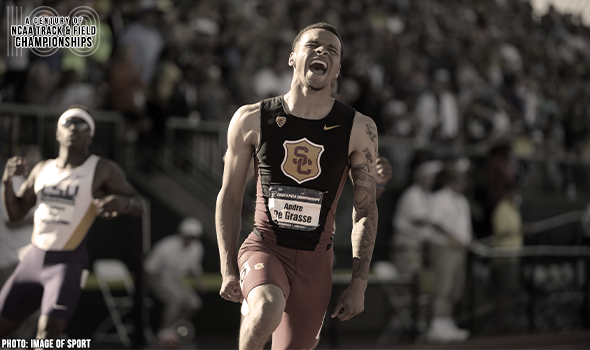
De Grasse Sprinted To Otherworldly Double
Andre De Grasse completed the 100-200 double at the 2015 NCAA DI Outdoor T&F Championships with scorching times: 9.75 (+2.7) in the 100; 19.58 (+2.4) in the 200.
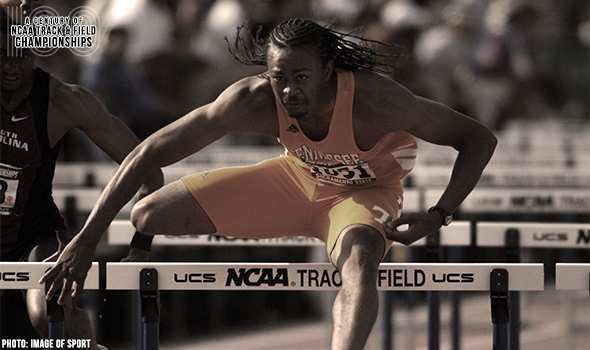
Merritt Broke Long-Standing 110H MR In 2006
Aries Merritt broke a 28-year-old meet record in the 110H when he won the crown at the 2006 NCAA DI Outdoor T&F Championships in 13.21.
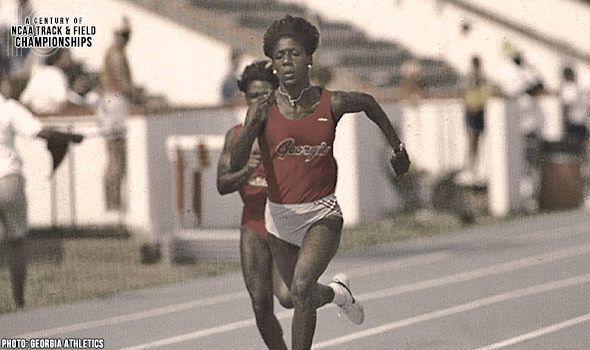
UGA’s Torrence Made NCAA History With Double
Gwen Torrence completed the 100-200 double at the 1987 NCAA DI Outdoor T&F Championships. Torrence was also the first woman to finish top-8 four times in the 100.
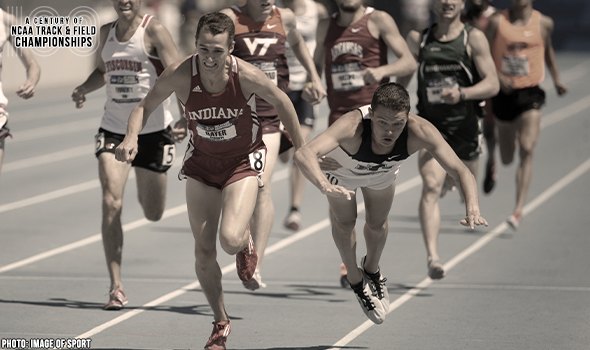
Bayer Gave It His All For NCAA 1500 Title
Andrew Bayer won the 1500 at the 2012 NCAA DI Outdoor Track & Field Championships in one of the closest finishes in meet history – 0.01 seconds.

Tipton Led 1-2-3 Oregon Finish In 1964 JT
Les Tipton led the first podium sweep of any event in the history of the NCAA Outdoor T&F Championships. Tipton and his Oregon teammates went 1-2-3 in the 1964 javelin.

K-State’s Jones Captured Heptathlon Crown In 2015
Akela Jones won the heptathlon at the 2015 NCAA DI Outdoor T&F Championships with 6371 points. That is the fourth-best score in both collegiate history & meet history.

Same Athletes, Same Result For LSU At NCAAs
The LSU foursome of Bennie Brazell, Pete Coley, Robert Parham, Kelly Willie swept the 4×100 & 4×400 crowns at the 2003 NCAA DI Outdoor T&F Championships.

Martin Won Distance Titles For Two Programs
Francis (Frank) Martin made history twice in the NCAA Outdoor Track & Field Championships.

FSU’s Williams Soared To Jumps Double In 2009
Kim Williams swept the horizontal jumps at the 2009 NCAA DI Outdoor T&F Championships. Williams was particularly dominant in the TJ, winning at 14.38m (47-2¼) & by nearly 2 feet.

